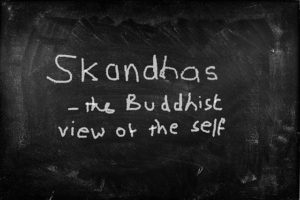
SKANDHAS (khandas, in Pali) – the Buddhist view of the Self
What Gotama Buddha perceived, when he watched carefully his own mental and emotional states, was a stream of ever-changing processes, a stream of moods, wishes, emotions, thoughts and images. He could find no evidence for an unchanging nucleus, soul or ego – he could find only a river of experiences and the currents of causality that flow in and through it. Thus, the term skandhas refers to this shifting stream of processes (or ‘aggregates’ as they are often described – the literal translation of skandha, is ‘heap, collection, groupings’).
Usually five kinds of skandha are described: rūpa – the physical world of form/matter; vedanā – the sensations and feelings we experience in response to physical stimuli – which may be pleasant, unpleasant or neutral; samjñā – the process of sorting, classifying and recognising, by which we perceive an apple as an apple or a table as a table or a person as a person; samskāra – the mental formations and forces (desires, impulses and will), and the habits of thought, behaviour and response built up over our lifetime, which drive our actions and mental responses; and, vijñāna – the process of being conscious and having awareness – including self-awareness .
It is where these currents of causality meet that our sense of self arises. We arise as the five skandhas interact – forming and reforming over time. From the Buddhist perspective there is no constant ‘self’ or fixed essence lying somewhere behind, inside, or independent from, the flow of skandhas. Our self is a process, not a ‘thing’. Maybe selfing is how we should describe the unfolding of our being.
If we closely examine our consciousness we notice that we can never pin down the ‘I’ that is having the experience. Whenever we think we have found the ‘I’ we find there is yet another ‘I’ who is doing the finding! It is as if there is no-one behind the counter, no-one standing at the back of the room of consciousness who owns all that happens in the room. Instead there is only a bewildering succession of ‘I’s, or rather a flickering stream of interconnected moments of consciousness, that, like frames in a reel of film give rise to a believable reality when they move at a particular speed and when light is projected through them.
Our sense of self arises from the interconnected and interwoven stream of moments of consciousness – the particular way in which the skandhas flow together. ‘Myself’, ‘me’ and ‘I’, are simply labels we apply to this particular combination of interdependent processes and causes – terms determined more by linguistic convention than by what actually exists. As such they are useful, and necessary for the purposes of discussion and analysis, but very misleading if we forget that there is no enduring essence or object behind the label. From a Buddhist perspective to be attached to a belief that there IS an independent self behind or underlying experience is to be deluded – to be in a state of ignorance (avidyā) as to how things actually are.
Gotama, speaking to his senior student, Ananda:
“It is by clinging, Ananda, that ‘I am’ occurs, not without clinging. It is by clinging to form, feelings, perceptions, inclinations and consciousness that ‘I am’ occurs, not without clinging.
“Suppose, friend Ananda, a young woman – or a man – youthful and fond of ornaments, examines her own facial image in a mirror or in a bowl filled with pure, clean water. She looks at it with emotional attachment, she clings to what she sees and believes it to be herself. She cannot see the forms for what they are: a transient play of light on the surface of glass or water. So too, it is by clinging to form that ‘I am’ occurs, without clinging there is no ‘I’….” (JD variation of Batchelor trans.)
